Sainsbury's: Strategic Marketing Plan for Indian Expansion Report
VerifiedAdded on 2020/11/12
|14
|4544
|61
Report
AI Summary
This report provides a strategic marketing analysis for Sainsbury's, focusing on its potential expansion into the Indian market with an ethnic product line. It begins with an executive summary and an introduction to strategic marketing, highlighting the importance of a strategic blueprint for achieving business objectives. The report then offers a company overview of Sainsbury's and proceeds with a detailed PESTLE analysis of the Indian market, identifying political, economic, social, technological, legal, and environmental factors influencing the firm's expansion. The analysis explores opportunities and threats within each factor, such as government support, economic growth, cultural diversity, technological advancements, cybercrime, legal regulations, and environmental concerns. The report further examines market entry modes, concluding that franchising would be the most suitable approach for Sainsbury's. It also details market segmentation and targeting, suggesting that urban customers with healthy lifestyles would be the primary target. Finally, the report recommends a differentiation strategy to gain a competitive edge over local and international competitors. The report concludes with a summary of findings and references.
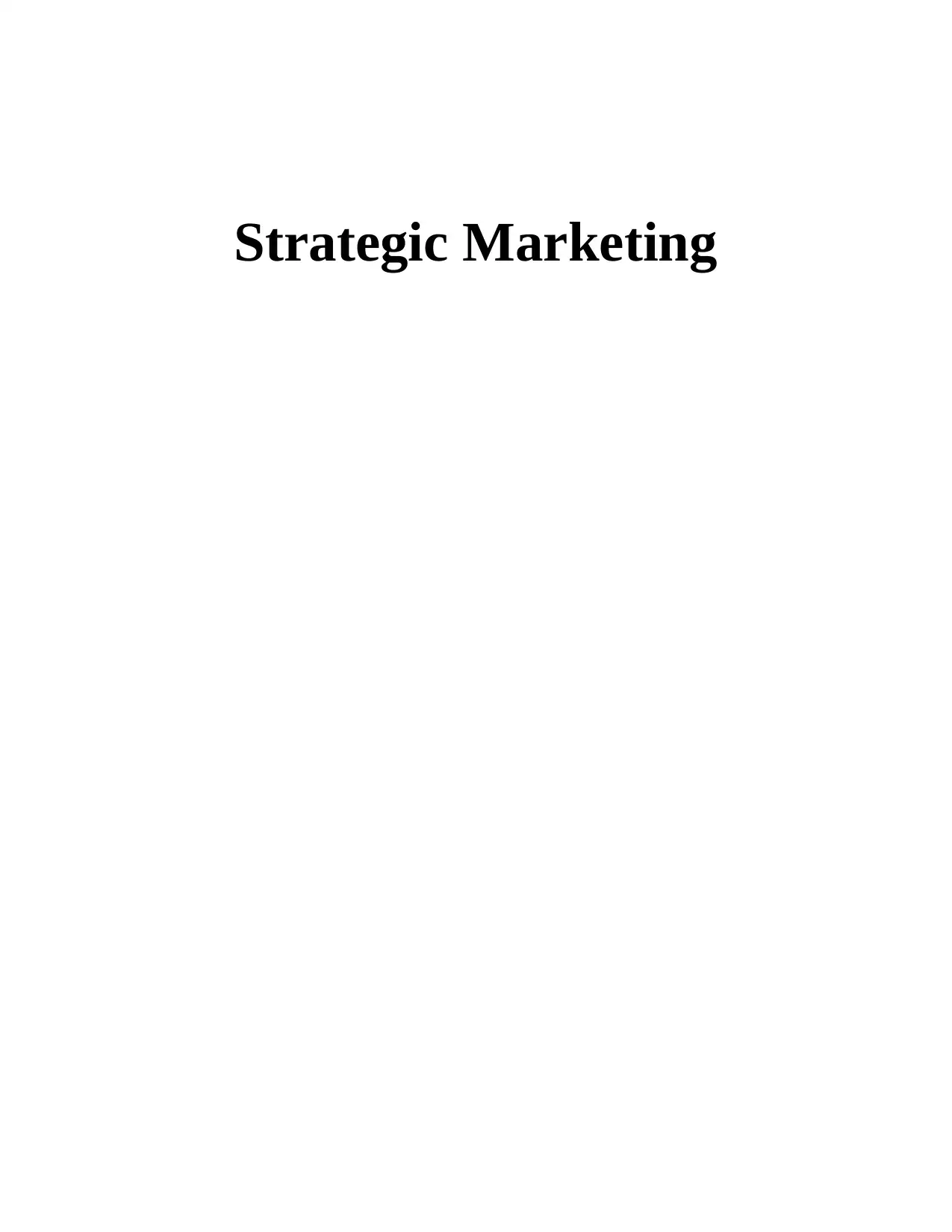
Strategic Marketing
Paraphrase This Document
Need a fresh take? Get an instant paraphrase of this document with our AI Paraphraser
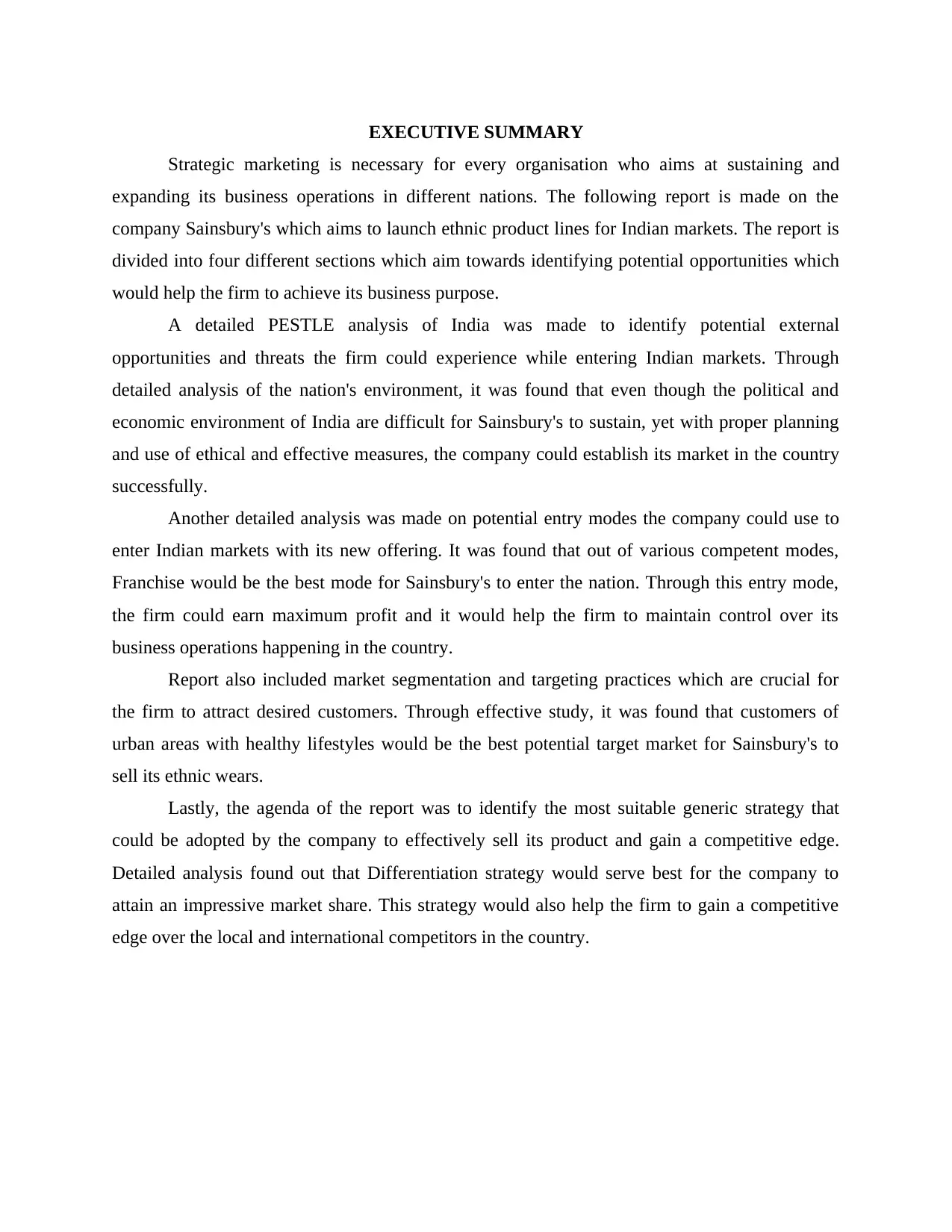
EXECUTIVE SUMMARY
Strategic marketing is necessary for every organisation who aims at sustaining and
expanding its business operations in different nations. The following report is made on the
company Sainsbury's which aims to launch ethnic product lines for Indian markets. The report is
divided into four different sections which aim towards identifying potential opportunities which
would help the firm to achieve its business purpose.
A detailed PESTLE analysis of India was made to identify potential external
opportunities and threats the firm could experience while entering Indian markets. Through
detailed analysis of the nation's environment, it was found that even though the political and
economic environment of India are difficult for Sainsbury's to sustain, yet with proper planning
and use of ethical and effective measures, the company could establish its market in the country
successfully.
Another detailed analysis was made on potential entry modes the company could use to
enter Indian markets with its new offering. It was found that out of various competent modes,
Franchise would be the best mode for Sainsbury's to enter the nation. Through this entry mode,
the firm could earn maximum profit and it would help the firm to maintain control over its
business operations happening in the country.
Report also included market segmentation and targeting practices which are crucial for
the firm to attract desired customers. Through effective study, it was found that customers of
urban areas with healthy lifestyles would be the best potential target market for Sainsbury's to
sell its ethnic wears.
Lastly, the agenda of the report was to identify the most suitable generic strategy that
could be adopted by the company to effectively sell its product and gain a competitive edge.
Detailed analysis found out that Differentiation strategy would serve best for the company to
attain an impressive market share. This strategy would also help the firm to gain a competitive
edge over the local and international competitors in the country.
Strategic marketing is necessary for every organisation who aims at sustaining and
expanding its business operations in different nations. The following report is made on the
company Sainsbury's which aims to launch ethnic product lines for Indian markets. The report is
divided into four different sections which aim towards identifying potential opportunities which
would help the firm to achieve its business purpose.
A detailed PESTLE analysis of India was made to identify potential external
opportunities and threats the firm could experience while entering Indian markets. Through
detailed analysis of the nation's environment, it was found that even though the political and
economic environment of India are difficult for Sainsbury's to sustain, yet with proper planning
and use of ethical and effective measures, the company could establish its market in the country
successfully.
Another detailed analysis was made on potential entry modes the company could use to
enter Indian markets with its new offering. It was found that out of various competent modes,
Franchise would be the best mode for Sainsbury's to enter the nation. Through this entry mode,
the firm could earn maximum profit and it would help the firm to maintain control over its
business operations happening in the country.
Report also included market segmentation and targeting practices which are crucial for
the firm to attract desired customers. Through effective study, it was found that customers of
urban areas with healthy lifestyles would be the best potential target market for Sainsbury's to
sell its ethnic wears.
Lastly, the agenda of the report was to identify the most suitable generic strategy that
could be adopted by the company to effectively sell its product and gain a competitive edge.
Detailed analysis found out that Differentiation strategy would serve best for the company to
attain an impressive market share. This strategy would also help the firm to gain a competitive
edge over the local and international competitors in the country.
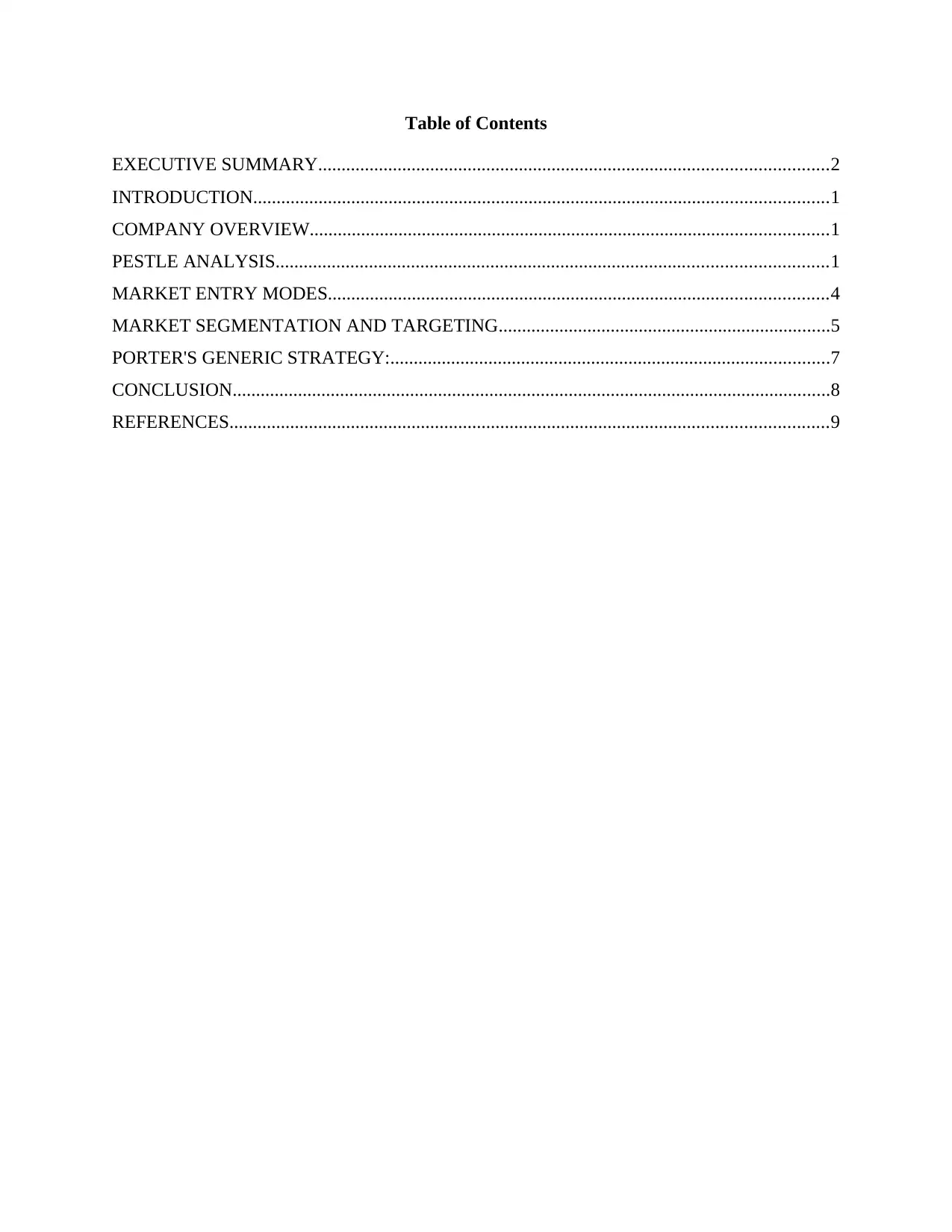
Table of Contents
EXECUTIVE SUMMARY.............................................................................................................2
INTRODUCTION...........................................................................................................................1
COMPANY OVERVIEW...............................................................................................................1
PESTLE ANALYSIS......................................................................................................................1
MARKET ENTRY MODES...........................................................................................................4
MARKET SEGMENTATION AND TARGETING.......................................................................5
PORTER'S GENERIC STRATEGY:..............................................................................................7
CONCLUSION................................................................................................................................8
REFERENCES................................................................................................................................9
EXECUTIVE SUMMARY.............................................................................................................2
INTRODUCTION...........................................................................................................................1
COMPANY OVERVIEW...............................................................................................................1
PESTLE ANALYSIS......................................................................................................................1
MARKET ENTRY MODES...........................................................................................................4
MARKET SEGMENTATION AND TARGETING.......................................................................5
PORTER'S GENERIC STRATEGY:..............................................................................................7
CONCLUSION................................................................................................................................8
REFERENCES................................................................................................................................9
⊘ This is a preview!⊘
Do you want full access?
Subscribe today to unlock all pages.

Trusted by 1+ million students worldwide
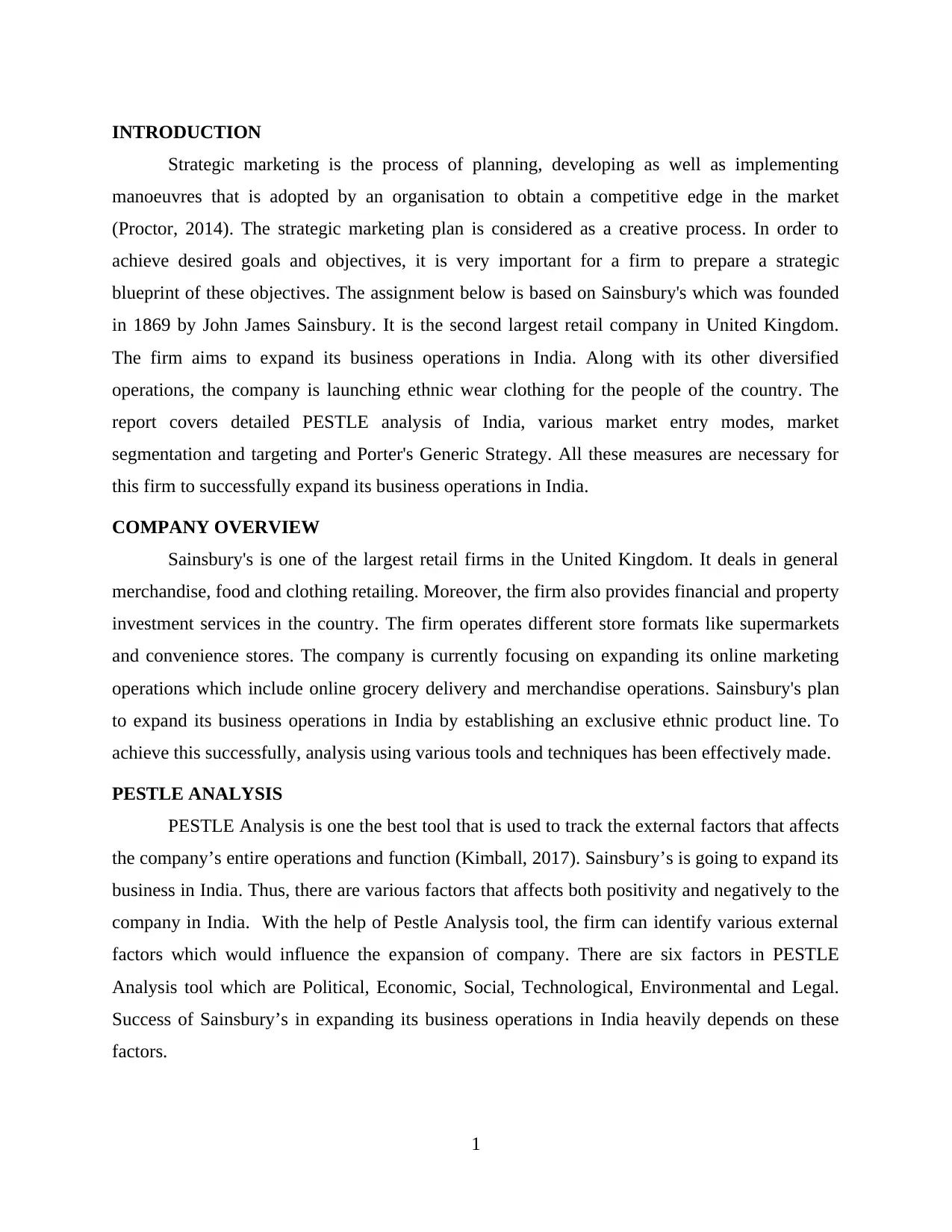
INTRODUCTION
Strategic marketing is the process of planning, developing as well as implementing
manoeuvres that is adopted by an organisation to obtain a competitive edge in the market
(Proctor, 2014). The strategic marketing plan is considered as a creative process. In order to
achieve desired goals and objectives, it is very important for a firm to prepare a strategic
blueprint of these objectives. The assignment below is based on Sainsbury's which was founded
in 1869 by John James Sainsbury. It is the second largest retail company in United Kingdom.
The firm aims to expand its business operations in India. Along with its other diversified
operations, the company is launching ethnic wear clothing for the people of the country. The
report covers detailed PESTLE analysis of India, various market entry modes, market
segmentation and targeting and Porter's Generic Strategy. All these measures are necessary for
this firm to successfully expand its business operations in India.
COMPANY OVERVIEW
Sainsbury's is one of the largest retail firms in the United Kingdom. It deals in general
merchandise, food and clothing retailing. Moreover, the firm also provides financial and property
investment services in the country. The firm operates different store formats like supermarkets
and convenience stores. The company is currently focusing on expanding its online marketing
operations which include online grocery delivery and merchandise operations. Sainsbury's plan
to expand its business operations in India by establishing an exclusive ethnic product line. To
achieve this successfully, analysis using various tools and techniques has been effectively made.
PESTLE ANALYSIS
PESTLE Analysis is one the best tool that is used to track the external factors that affects
the company’s entire operations and function (Kimball, 2017). Sainsbury’s is going to expand its
business in India. Thus, there are various factors that affects both positivity and negatively to the
company in India. With the help of Pestle Analysis tool, the firm can identify various external
factors which would influence the expansion of company. There are six factors in PESTLE
Analysis tool which are Political, Economic, Social, Technological, Environmental and Legal.
Success of Sainsbury’s in expanding its business operations in India heavily depends on these
factors.
1
Strategic marketing is the process of planning, developing as well as implementing
manoeuvres that is adopted by an organisation to obtain a competitive edge in the market
(Proctor, 2014). The strategic marketing plan is considered as a creative process. In order to
achieve desired goals and objectives, it is very important for a firm to prepare a strategic
blueprint of these objectives. The assignment below is based on Sainsbury's which was founded
in 1869 by John James Sainsbury. It is the second largest retail company in United Kingdom.
The firm aims to expand its business operations in India. Along with its other diversified
operations, the company is launching ethnic wear clothing for the people of the country. The
report covers detailed PESTLE analysis of India, various market entry modes, market
segmentation and targeting and Porter's Generic Strategy. All these measures are necessary for
this firm to successfully expand its business operations in India.
COMPANY OVERVIEW
Sainsbury's is one of the largest retail firms in the United Kingdom. It deals in general
merchandise, food and clothing retailing. Moreover, the firm also provides financial and property
investment services in the country. The firm operates different store formats like supermarkets
and convenience stores. The company is currently focusing on expanding its online marketing
operations which include online grocery delivery and merchandise operations. Sainsbury's plan
to expand its business operations in India by establishing an exclusive ethnic product line. To
achieve this successfully, analysis using various tools and techniques has been effectively made.
PESTLE ANALYSIS
PESTLE Analysis is one the best tool that is used to track the external factors that affects
the company’s entire operations and function (Kimball, 2017). Sainsbury’s is going to expand its
business in India. Thus, there are various factors that affects both positivity and negatively to the
company in India. With the help of Pestle Analysis tool, the firm can identify various external
factors which would influence the expansion of company. There are six factors in PESTLE
Analysis tool which are Political, Economic, Social, Technological, Environmental and Legal.
Success of Sainsbury’s in expanding its business operations in India heavily depends on these
factors.
1
Paraphrase This Document
Need a fresh take? Get an instant paraphrase of this document with our AI Paraphraser
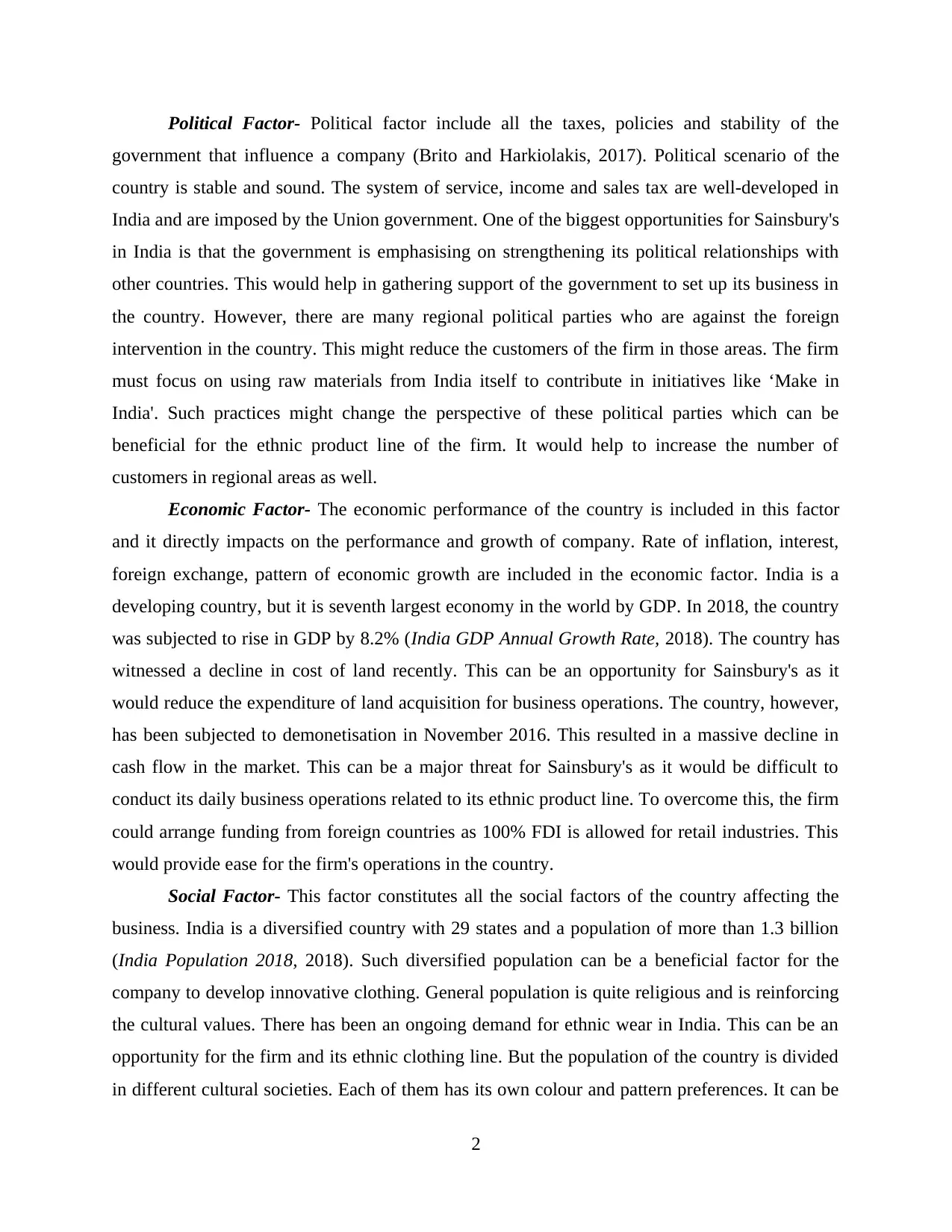
Political Factor- Political factor include all the taxes, policies and stability of the
government that influence a company (Brito and Harkiolakis, 2017). Political scenario of the
country is stable and sound. The system of service, income and sales tax are well-developed in
India and are imposed by the Union government. One of the biggest opportunities for Sainsbury's
in India is that the government is emphasising on strengthening its political relationships with
other countries. This would help in gathering support of the government to set up its business in
the country. However, there are many regional political parties who are against the foreign
intervention in the country. This might reduce the customers of the firm in those areas. The firm
must focus on using raw materials from India itself to contribute in initiatives like ‘Make in
India'. Such practices might change the perspective of these political parties which can be
beneficial for the ethnic product line of the firm. It would help to increase the number of
customers in regional areas as well.
Economic Factor- The economic performance of the country is included in this factor
and it directly impacts on the performance and growth of company. Rate of inflation, interest,
foreign exchange, pattern of economic growth are included in the economic factor. India is a
developing country, but it is seventh largest economy in the world by GDP. In 2018, the country
was subjected to rise in GDP by 8.2% (India GDP Annual Growth Rate, 2018). The country has
witnessed a decline in cost of land recently. This can be an opportunity for Sainsbury's as it
would reduce the expenditure of land acquisition for business operations. The country, however,
has been subjected to demonetisation in November 2016. This resulted in a massive decline in
cash flow in the market. This can be a major threat for Sainsbury's as it would be difficult to
conduct its daily business operations related to its ethnic product line. To overcome this, the firm
could arrange funding from foreign countries as 100% FDI is allowed for retail industries. This
would provide ease for the firm's operations in the country.
Social Factor- This factor constitutes all the social factors of the country affecting the
business. India is a diversified country with 29 states and a population of more than 1.3 billion
(India Population 2018, 2018). Such diversified population can be a beneficial factor for the
company to develop innovative clothing. General population is quite religious and is reinforcing
the cultural values. There has been an ongoing demand for ethnic wear in India. This can be an
opportunity for the firm and its ethnic clothing line. But the population of the country is divided
in different cultural societies. Each of them has its own colour and pattern preferences. It can be
2
government that influence a company (Brito and Harkiolakis, 2017). Political scenario of the
country is stable and sound. The system of service, income and sales tax are well-developed in
India and are imposed by the Union government. One of the biggest opportunities for Sainsbury's
in India is that the government is emphasising on strengthening its political relationships with
other countries. This would help in gathering support of the government to set up its business in
the country. However, there are many regional political parties who are against the foreign
intervention in the country. This might reduce the customers of the firm in those areas. The firm
must focus on using raw materials from India itself to contribute in initiatives like ‘Make in
India'. Such practices might change the perspective of these political parties which can be
beneficial for the ethnic product line of the firm. It would help to increase the number of
customers in regional areas as well.
Economic Factor- The economic performance of the country is included in this factor
and it directly impacts on the performance and growth of company. Rate of inflation, interest,
foreign exchange, pattern of economic growth are included in the economic factor. India is a
developing country, but it is seventh largest economy in the world by GDP. In 2018, the country
was subjected to rise in GDP by 8.2% (India GDP Annual Growth Rate, 2018). The country has
witnessed a decline in cost of land recently. This can be an opportunity for Sainsbury's as it
would reduce the expenditure of land acquisition for business operations. The country, however,
has been subjected to demonetisation in November 2016. This resulted in a massive decline in
cash flow in the market. This can be a major threat for Sainsbury's as it would be difficult to
conduct its daily business operations related to its ethnic product line. To overcome this, the firm
could arrange funding from foreign countries as 100% FDI is allowed for retail industries. This
would provide ease for the firm's operations in the country.
Social Factor- This factor constitutes all the social factors of the country affecting the
business. India is a diversified country with 29 states and a population of more than 1.3 billion
(India Population 2018, 2018). Such diversified population can be a beneficial factor for the
company to develop innovative clothing. General population is quite religious and is reinforcing
the cultural values. There has been an ongoing demand for ethnic wear in India. This can be an
opportunity for the firm and its ethnic clothing line. But the population of the country is divided
in different cultural societies. Each of them has its own colour and pattern preferences. It can be
2
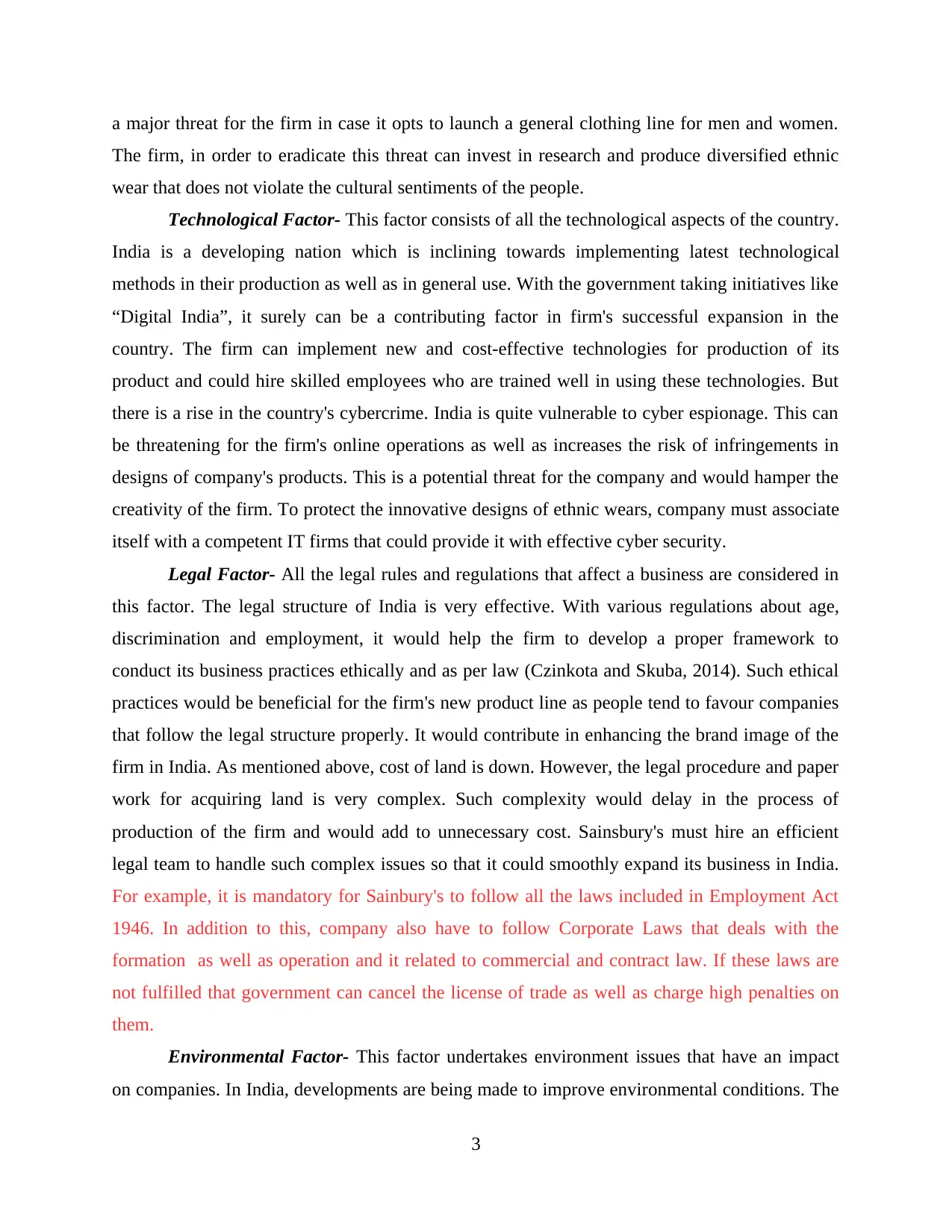
a major threat for the firm in case it opts to launch a general clothing line for men and women.
The firm, in order to eradicate this threat can invest in research and produce diversified ethnic
wear that does not violate the cultural sentiments of the people.
Technological Factor- This factor consists of all the technological aspects of the country.
India is a developing nation which is inclining towards implementing latest technological
methods in their production as well as in general use. With the government taking initiatives like
“Digital India”, it surely can be a contributing factor in firm's successful expansion in the
country. The firm can implement new and cost-effective technologies for production of its
product and could hire skilled employees who are trained well in using these technologies. But
there is a rise in the country's cybercrime. India is quite vulnerable to cyber espionage. This can
be threatening for the firm's online operations as well as increases the risk of infringements in
designs of company's products. This is a potential threat for the company and would hamper the
creativity of the firm. To protect the innovative designs of ethnic wears, company must associate
itself with a competent IT firms that could provide it with effective cyber security.
Legal Factor- All the legal rules and regulations that affect a business are considered in
this factor. The legal structure of India is very effective. With various regulations about age,
discrimination and employment, it would help the firm to develop a proper framework to
conduct its business practices ethically and as per law (Czinkota and Skuba, 2014). Such ethical
practices would be beneficial for the firm's new product line as people tend to favour companies
that follow the legal structure properly. It would contribute in enhancing the brand image of the
firm in India. As mentioned above, cost of land is down. However, the legal procedure and paper
work for acquiring land is very complex. Such complexity would delay in the process of
production of the firm and would add to unnecessary cost. Sainsbury's must hire an efficient
legal team to handle such complex issues so that it could smoothly expand its business in India.
For example, it is mandatory for Sainbury's to follow all the laws included in Employment Act
1946. In addition to this, company also have to follow Corporate Laws that deals with the
formation as well as operation and it related to commercial and contract law. If these laws are
not fulfilled that government can cancel the license of trade as well as charge high penalties on
them.
Environmental Factor- This factor undertakes environment issues that have an impact
on companies. In India, developments are being made to improve environmental conditions. The
3
The firm, in order to eradicate this threat can invest in research and produce diversified ethnic
wear that does not violate the cultural sentiments of the people.
Technological Factor- This factor consists of all the technological aspects of the country.
India is a developing nation which is inclining towards implementing latest technological
methods in their production as well as in general use. With the government taking initiatives like
“Digital India”, it surely can be a contributing factor in firm's successful expansion in the
country. The firm can implement new and cost-effective technologies for production of its
product and could hire skilled employees who are trained well in using these technologies. But
there is a rise in the country's cybercrime. India is quite vulnerable to cyber espionage. This can
be threatening for the firm's online operations as well as increases the risk of infringements in
designs of company's products. This is a potential threat for the company and would hamper the
creativity of the firm. To protect the innovative designs of ethnic wears, company must associate
itself with a competent IT firms that could provide it with effective cyber security.
Legal Factor- All the legal rules and regulations that affect a business are considered in
this factor. The legal structure of India is very effective. With various regulations about age,
discrimination and employment, it would help the firm to develop a proper framework to
conduct its business practices ethically and as per law (Czinkota and Skuba, 2014). Such ethical
practices would be beneficial for the firm's new product line as people tend to favour companies
that follow the legal structure properly. It would contribute in enhancing the brand image of the
firm in India. As mentioned above, cost of land is down. However, the legal procedure and paper
work for acquiring land is very complex. Such complexity would delay in the process of
production of the firm and would add to unnecessary cost. Sainsbury's must hire an efficient
legal team to handle such complex issues so that it could smoothly expand its business in India.
For example, it is mandatory for Sainbury's to follow all the laws included in Employment Act
1946. In addition to this, company also have to follow Corporate Laws that deals with the
formation as well as operation and it related to commercial and contract law. If these laws are
not fulfilled that government can cancel the license of trade as well as charge high penalties on
them.
Environmental Factor- This factor undertakes environment issues that have an impact
on companies. In India, developments are being made to improve environmental conditions. The
3
⊘ This is a preview!⊘
Do you want full access?
Subscribe today to unlock all pages.

Trusted by 1+ million students worldwide
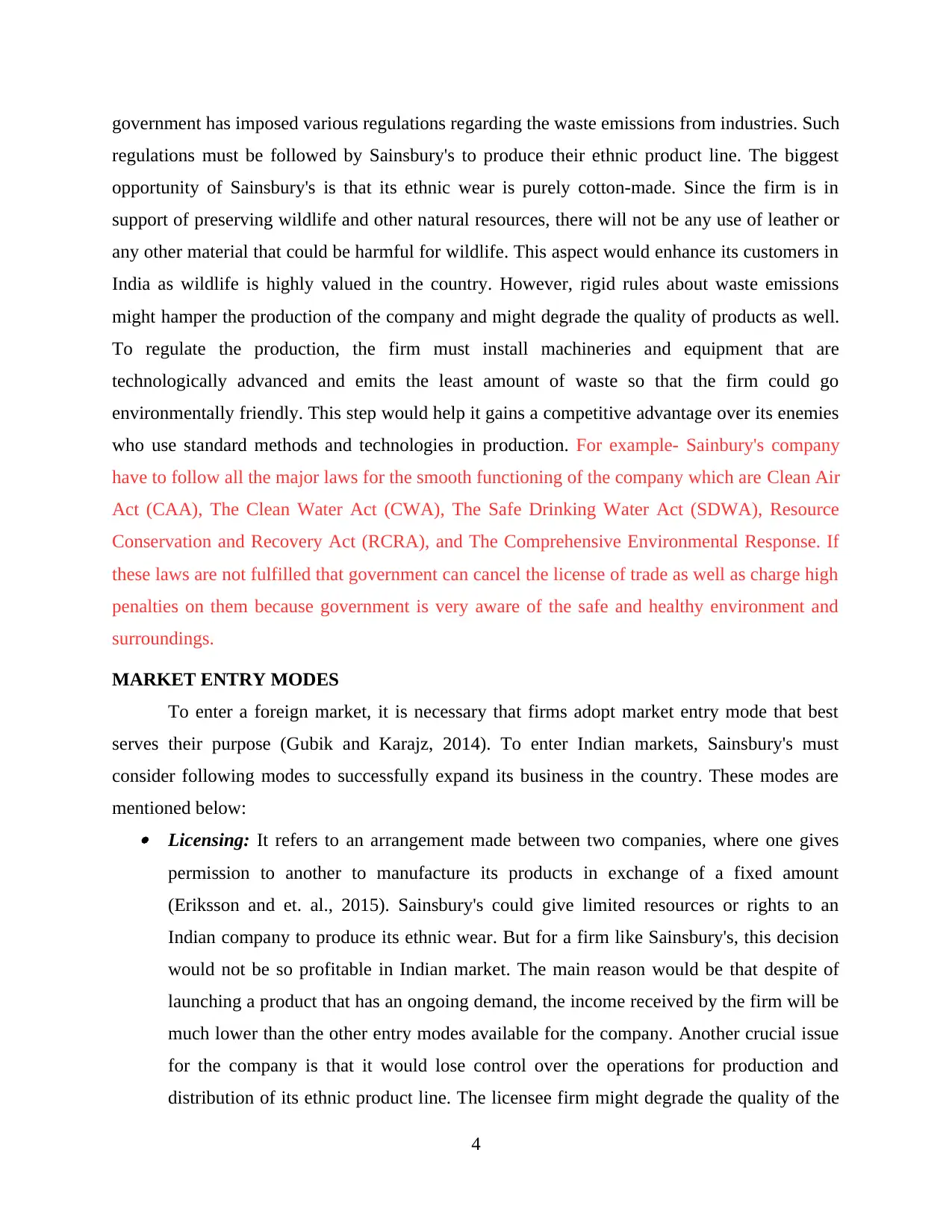
government has imposed various regulations regarding the waste emissions from industries. Such
regulations must be followed by Sainsbury's to produce their ethnic product line. The biggest
opportunity of Sainsbury's is that its ethnic wear is purely cotton-made. Since the firm is in
support of preserving wildlife and other natural resources, there will not be any use of leather or
any other material that could be harmful for wildlife. This aspect would enhance its customers in
India as wildlife is highly valued in the country. However, rigid rules about waste emissions
might hamper the production of the company and might degrade the quality of products as well.
To regulate the production, the firm must install machineries and equipment that are
technologically advanced and emits the least amount of waste so that the firm could go
environmentally friendly. This step would help it gains a competitive advantage over its enemies
who use standard methods and technologies in production. For example- Sainbury's company
have to follow all the major laws for the smooth functioning of the company which are Clean Air
Act (CAA), The Clean Water Act (CWA), The Safe Drinking Water Act (SDWA), Resource
Conservation and Recovery Act (RCRA), and The Comprehensive Environmental Response. If
these laws are not fulfilled that government can cancel the license of trade as well as charge high
penalties on them because government is very aware of the safe and healthy environment and
surroundings.
MARKET ENTRY MODES
To enter a foreign market, it is necessary that firms adopt market entry mode that best
serves their purpose (Gubik and Karajz, 2014). To enter Indian markets, Sainsbury's must
consider following modes to successfully expand its business in the country. These modes are
mentioned below: Licensing: It refers to an arrangement made between two companies, where one gives
permission to another to manufacture its products in exchange of a fixed amount
(Eriksson and et. al., 2015). Sainsbury's could give limited resources or rights to an
Indian company to produce its ethnic wear. But for a firm like Sainsbury's, this decision
would not be so profitable in Indian market. The main reason would be that despite of
launching a product that has an ongoing demand, the income received by the firm will be
much lower than the other entry modes available for the company. Another crucial issue
for the company is that it would lose control over the operations for production and
distribution of its ethnic product line. The licensee firm might degrade the quality of the
4
regulations must be followed by Sainsbury's to produce their ethnic product line. The biggest
opportunity of Sainsbury's is that its ethnic wear is purely cotton-made. Since the firm is in
support of preserving wildlife and other natural resources, there will not be any use of leather or
any other material that could be harmful for wildlife. This aspect would enhance its customers in
India as wildlife is highly valued in the country. However, rigid rules about waste emissions
might hamper the production of the company and might degrade the quality of products as well.
To regulate the production, the firm must install machineries and equipment that are
technologically advanced and emits the least amount of waste so that the firm could go
environmentally friendly. This step would help it gains a competitive advantage over its enemies
who use standard methods and technologies in production. For example- Sainbury's company
have to follow all the major laws for the smooth functioning of the company which are Clean Air
Act (CAA), The Clean Water Act (CWA), The Safe Drinking Water Act (SDWA), Resource
Conservation and Recovery Act (RCRA), and The Comprehensive Environmental Response. If
these laws are not fulfilled that government can cancel the license of trade as well as charge high
penalties on them because government is very aware of the safe and healthy environment and
surroundings.
MARKET ENTRY MODES
To enter a foreign market, it is necessary that firms adopt market entry mode that best
serves their purpose (Gubik and Karajz, 2014). To enter Indian markets, Sainsbury's must
consider following modes to successfully expand its business in the country. These modes are
mentioned below: Licensing: It refers to an arrangement made between two companies, where one gives
permission to another to manufacture its products in exchange of a fixed amount
(Eriksson and et. al., 2015). Sainsbury's could give limited resources or rights to an
Indian company to produce its ethnic wear. But for a firm like Sainsbury's, this decision
would not be so profitable in Indian market. The main reason would be that despite of
launching a product that has an ongoing demand, the income received by the firm will be
much lower than the other entry modes available for the company. Another crucial issue
for the company is that it would lose control over the operations for production and
distribution of its ethnic product line. The licensee firm might degrade the quality of the
4
Paraphrase This Document
Need a fresh take? Get an instant paraphrase of this document with our AI Paraphraser
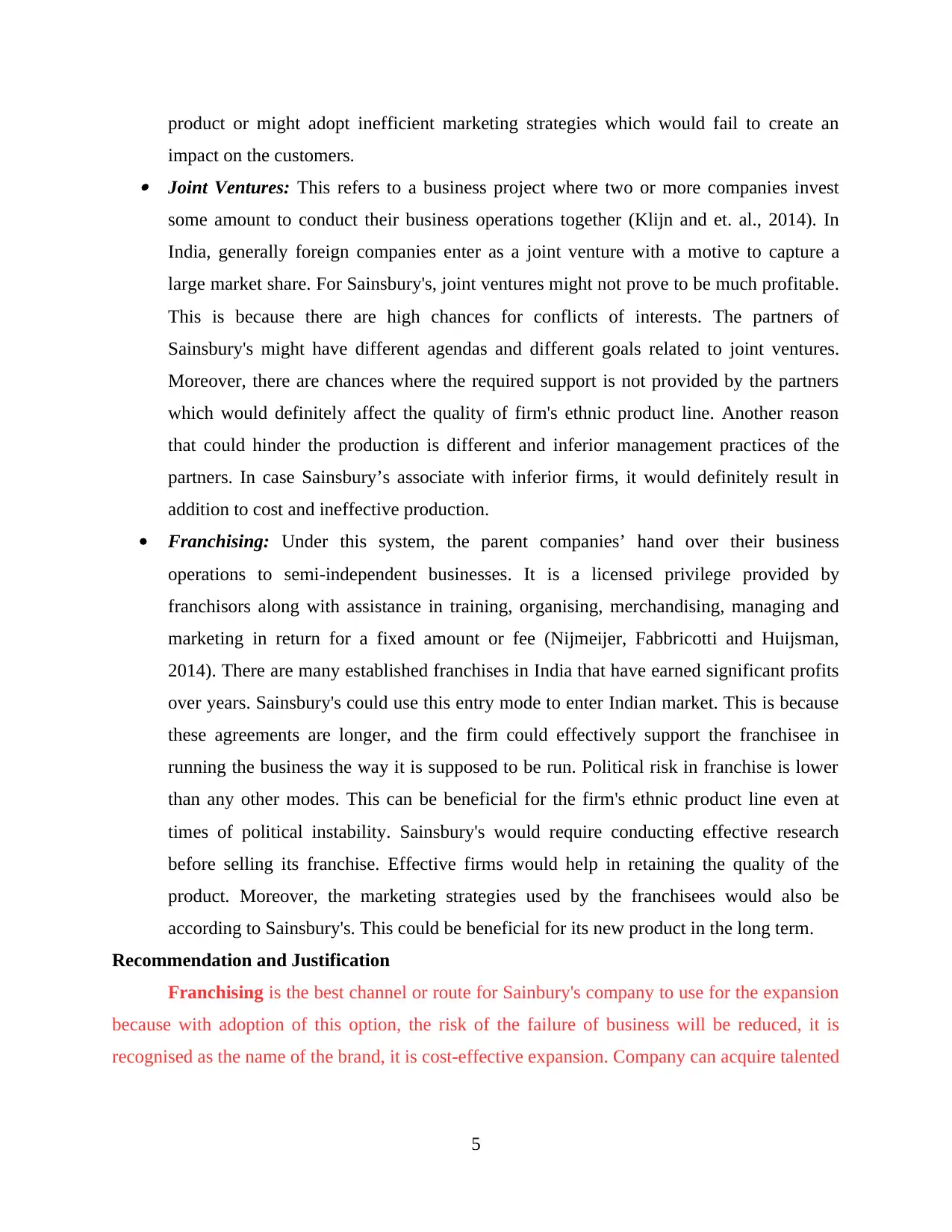
product or might adopt inefficient marketing strategies which would fail to create an
impact on the customers. Joint Ventures: This refers to a business project where two or more companies invest
some amount to conduct their business operations together (Klijn and et. al., 2014). In
India, generally foreign companies enter as a joint venture with a motive to capture a
large market share. For Sainsbury's, joint ventures might not prove to be much profitable.
This is because there are high chances for conflicts of interests. The partners of
Sainsbury's might have different agendas and different goals related to joint ventures.
Moreover, there are chances where the required support is not provided by the partners
which would definitely affect the quality of firm's ethnic product line. Another reason
that could hinder the production is different and inferior management practices of the
partners. In case Sainsbury’s associate with inferior firms, it would definitely result in
addition to cost and ineffective production.
Franchising: Under this system, the parent companies’ hand over their business
operations to semi-independent businesses. It is a licensed privilege provided by
franchisors along with assistance in training, organising, merchandising, managing and
marketing in return for a fixed amount or fee (Nijmeijer, Fabbricotti and Huijsman,
2014). There are many established franchises in India that have earned significant profits
over years. Sainsbury's could use this entry mode to enter Indian market. This is because
these agreements are longer, and the firm could effectively support the franchisee in
running the business the way it is supposed to be run. Political risk in franchise is lower
than any other modes. This can be beneficial for the firm's ethnic product line even at
times of political instability. Sainsbury's would require conducting effective research
before selling its franchise. Effective firms would help in retaining the quality of the
product. Moreover, the marketing strategies used by the franchisees would also be
according to Sainsbury's. This could be beneficial for its new product in the long term.
Recommendation and Justification
Franchising is the best channel or route for Sainbury's company to use for the expansion
because with adoption of this option, the risk of the failure of business will be reduced, it is
recognised as the name of the brand, it is cost-effective expansion. Company can acquire talented
5
impact on the customers. Joint Ventures: This refers to a business project where two or more companies invest
some amount to conduct their business operations together (Klijn and et. al., 2014). In
India, generally foreign companies enter as a joint venture with a motive to capture a
large market share. For Sainsbury's, joint ventures might not prove to be much profitable.
This is because there are high chances for conflicts of interests. The partners of
Sainsbury's might have different agendas and different goals related to joint ventures.
Moreover, there are chances where the required support is not provided by the partners
which would definitely affect the quality of firm's ethnic product line. Another reason
that could hinder the production is different and inferior management practices of the
partners. In case Sainsbury’s associate with inferior firms, it would definitely result in
addition to cost and ineffective production.
Franchising: Under this system, the parent companies’ hand over their business
operations to semi-independent businesses. It is a licensed privilege provided by
franchisors along with assistance in training, organising, merchandising, managing and
marketing in return for a fixed amount or fee (Nijmeijer, Fabbricotti and Huijsman,
2014). There are many established franchises in India that have earned significant profits
over years. Sainsbury's could use this entry mode to enter Indian market. This is because
these agreements are longer, and the firm could effectively support the franchisee in
running the business the way it is supposed to be run. Political risk in franchise is lower
than any other modes. This can be beneficial for the firm's ethnic product line even at
times of political instability. Sainsbury's would require conducting effective research
before selling its franchise. Effective firms would help in retaining the quality of the
product. Moreover, the marketing strategies used by the franchisees would also be
according to Sainsbury's. This could be beneficial for its new product in the long term.
Recommendation and Justification
Franchising is the best channel or route for Sainbury's company to use for the expansion
because with adoption of this option, the risk of the failure of business will be reduced, it is
recognised as the name of the brand, it is cost-effective expansion. Company can acquire talented
5
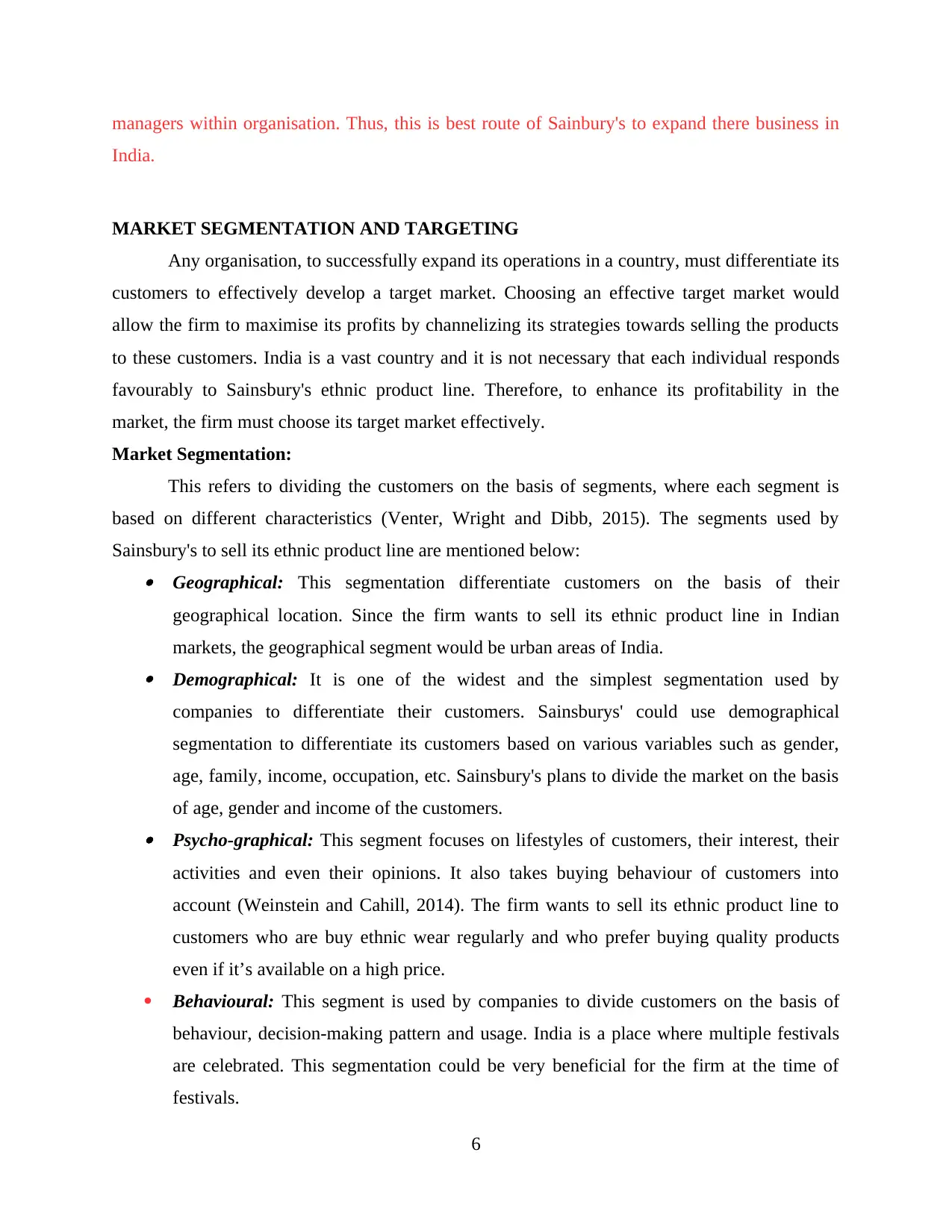
managers within organisation. Thus, this is best route of Sainbury's to expand there business in
India.
MARKET SEGMENTATION AND TARGETING
Any organisation, to successfully expand its operations in a country, must differentiate its
customers to effectively develop a target market. Choosing an effective target market would
allow the firm to maximise its profits by channelizing its strategies towards selling the products
to these customers. India is a vast country and it is not necessary that each individual responds
favourably to Sainsbury's ethnic product line. Therefore, to enhance its profitability in the
market, the firm must choose its target market effectively.
Market Segmentation:
This refers to dividing the customers on the basis of segments, where each segment is
based on different characteristics (Venter, Wright and Dibb, 2015). The segments used by
Sainsbury's to sell its ethnic product line are mentioned below: Geographical: This segmentation differentiate customers on the basis of their
geographical location. Since the firm wants to sell its ethnic product line in Indian
markets, the geographical segment would be urban areas of India. Demographical: It is one of the widest and the simplest segmentation used by
companies to differentiate their customers. Sainsburys' could use demographical
segmentation to differentiate its customers based on various variables such as gender,
age, family, income, occupation, etc. Sainsbury's plans to divide the market on the basis
of age, gender and income of the customers. Psycho-graphical: This segment focuses on lifestyles of customers, their interest, their
activities and even their opinions. It also takes buying behaviour of customers into
account (Weinstein and Cahill, 2014). The firm wants to sell its ethnic product line to
customers who are buy ethnic wear regularly and who prefer buying quality products
even if it’s available on a high price.
Behavioural: This segment is used by companies to divide customers on the basis of
behaviour, decision-making pattern and usage. India is a place where multiple festivals
are celebrated. This segmentation could be very beneficial for the firm at the time of
festivals.
6
India.
MARKET SEGMENTATION AND TARGETING
Any organisation, to successfully expand its operations in a country, must differentiate its
customers to effectively develop a target market. Choosing an effective target market would
allow the firm to maximise its profits by channelizing its strategies towards selling the products
to these customers. India is a vast country and it is not necessary that each individual responds
favourably to Sainsbury's ethnic product line. Therefore, to enhance its profitability in the
market, the firm must choose its target market effectively.
Market Segmentation:
This refers to dividing the customers on the basis of segments, where each segment is
based on different characteristics (Venter, Wright and Dibb, 2015). The segments used by
Sainsbury's to sell its ethnic product line are mentioned below: Geographical: This segmentation differentiate customers on the basis of their
geographical location. Since the firm wants to sell its ethnic product line in Indian
markets, the geographical segment would be urban areas of India. Demographical: It is one of the widest and the simplest segmentation used by
companies to differentiate their customers. Sainsburys' could use demographical
segmentation to differentiate its customers based on various variables such as gender,
age, family, income, occupation, etc. Sainsbury's plans to divide the market on the basis
of age, gender and income of the customers. Psycho-graphical: This segment focuses on lifestyles of customers, their interest, their
activities and even their opinions. It also takes buying behaviour of customers into
account (Weinstein and Cahill, 2014). The firm wants to sell its ethnic product line to
customers who are buy ethnic wear regularly and who prefer buying quality products
even if it’s available on a high price.
Behavioural: This segment is used by companies to divide customers on the basis of
behaviour, decision-making pattern and usage. India is a place where multiple festivals
are celebrated. This segmentation could be very beneficial for the firm at the time of
festivals.
6
⊘ This is a preview!⊘
Do you want full access?
Subscribe today to unlock all pages.

Trusted by 1+ million students worldwide
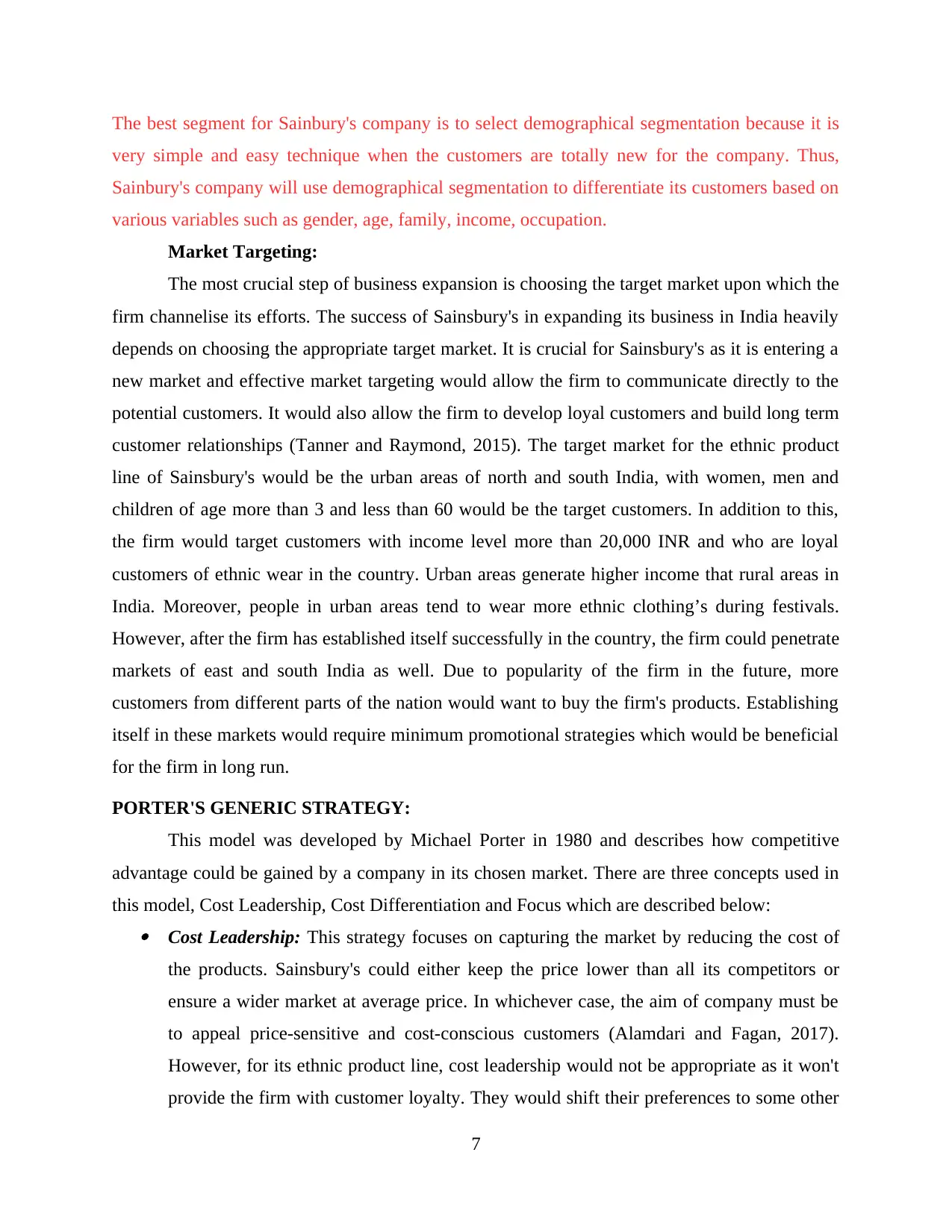
The best segment for Sainbury's company is to select demographical segmentation because it is
very simple and easy technique when the customers are totally new for the company. Thus,
Sainbury's company will use demographical segmentation to differentiate its customers based on
various variables such as gender, age, family, income, occupation.
Market Targeting:
The most crucial step of business expansion is choosing the target market upon which the
firm channelise its efforts. The success of Sainsbury's in expanding its business in India heavily
depends on choosing the appropriate target market. It is crucial for Sainsbury's as it is entering a
new market and effective market targeting would allow the firm to communicate directly to the
potential customers. It would also allow the firm to develop loyal customers and build long term
customer relationships (Tanner and Raymond, 2015). The target market for the ethnic product
line of Sainsbury's would be the urban areas of north and south India, with women, men and
children of age more than 3 and less than 60 would be the target customers. In addition to this,
the firm would target customers with income level more than 20,000 INR and who are loyal
customers of ethnic wear in the country. Urban areas generate higher income that rural areas in
India. Moreover, people in urban areas tend to wear more ethnic clothing’s during festivals.
However, after the firm has established itself successfully in the country, the firm could penetrate
markets of east and south India as well. Due to popularity of the firm in the future, more
customers from different parts of the nation would want to buy the firm's products. Establishing
itself in these markets would require minimum promotional strategies which would be beneficial
for the firm in long run.
PORTER'S GENERIC STRATEGY:
This model was developed by Michael Porter in 1980 and describes how competitive
advantage could be gained by a company in its chosen market. There are three concepts used in
this model, Cost Leadership, Cost Differentiation and Focus which are described below: Cost Leadership: This strategy focuses on capturing the market by reducing the cost of
the products. Sainsbury's could either keep the price lower than all its competitors or
ensure a wider market at average price. In whichever case, the aim of company must be
to appeal price-sensitive and cost-conscious customers (Alamdari and Fagan, 2017).
However, for its ethnic product line, cost leadership would not be appropriate as it won't
provide the firm with customer loyalty. They would shift their preferences to some other
7
very simple and easy technique when the customers are totally new for the company. Thus,
Sainbury's company will use demographical segmentation to differentiate its customers based on
various variables such as gender, age, family, income, occupation.
Market Targeting:
The most crucial step of business expansion is choosing the target market upon which the
firm channelise its efforts. The success of Sainsbury's in expanding its business in India heavily
depends on choosing the appropriate target market. It is crucial for Sainsbury's as it is entering a
new market and effective market targeting would allow the firm to communicate directly to the
potential customers. It would also allow the firm to develop loyal customers and build long term
customer relationships (Tanner and Raymond, 2015). The target market for the ethnic product
line of Sainsbury's would be the urban areas of north and south India, with women, men and
children of age more than 3 and less than 60 would be the target customers. In addition to this,
the firm would target customers with income level more than 20,000 INR and who are loyal
customers of ethnic wear in the country. Urban areas generate higher income that rural areas in
India. Moreover, people in urban areas tend to wear more ethnic clothing’s during festivals.
However, after the firm has established itself successfully in the country, the firm could penetrate
markets of east and south India as well. Due to popularity of the firm in the future, more
customers from different parts of the nation would want to buy the firm's products. Establishing
itself in these markets would require minimum promotional strategies which would be beneficial
for the firm in long run.
PORTER'S GENERIC STRATEGY:
This model was developed by Michael Porter in 1980 and describes how competitive
advantage could be gained by a company in its chosen market. There are three concepts used in
this model, Cost Leadership, Cost Differentiation and Focus which are described below: Cost Leadership: This strategy focuses on capturing the market by reducing the cost of
the products. Sainsbury's could either keep the price lower than all its competitors or
ensure a wider market at average price. In whichever case, the aim of company must be
to appeal price-sensitive and cost-conscious customers (Alamdari and Fagan, 2017).
However, for its ethnic product line, cost leadership would not be appropriate as it won't
provide the firm with customer loyalty. They would shift their preferences to some other
7
Paraphrase This Document
Need a fresh take? Get an instant paraphrase of this document with our AI Paraphraser
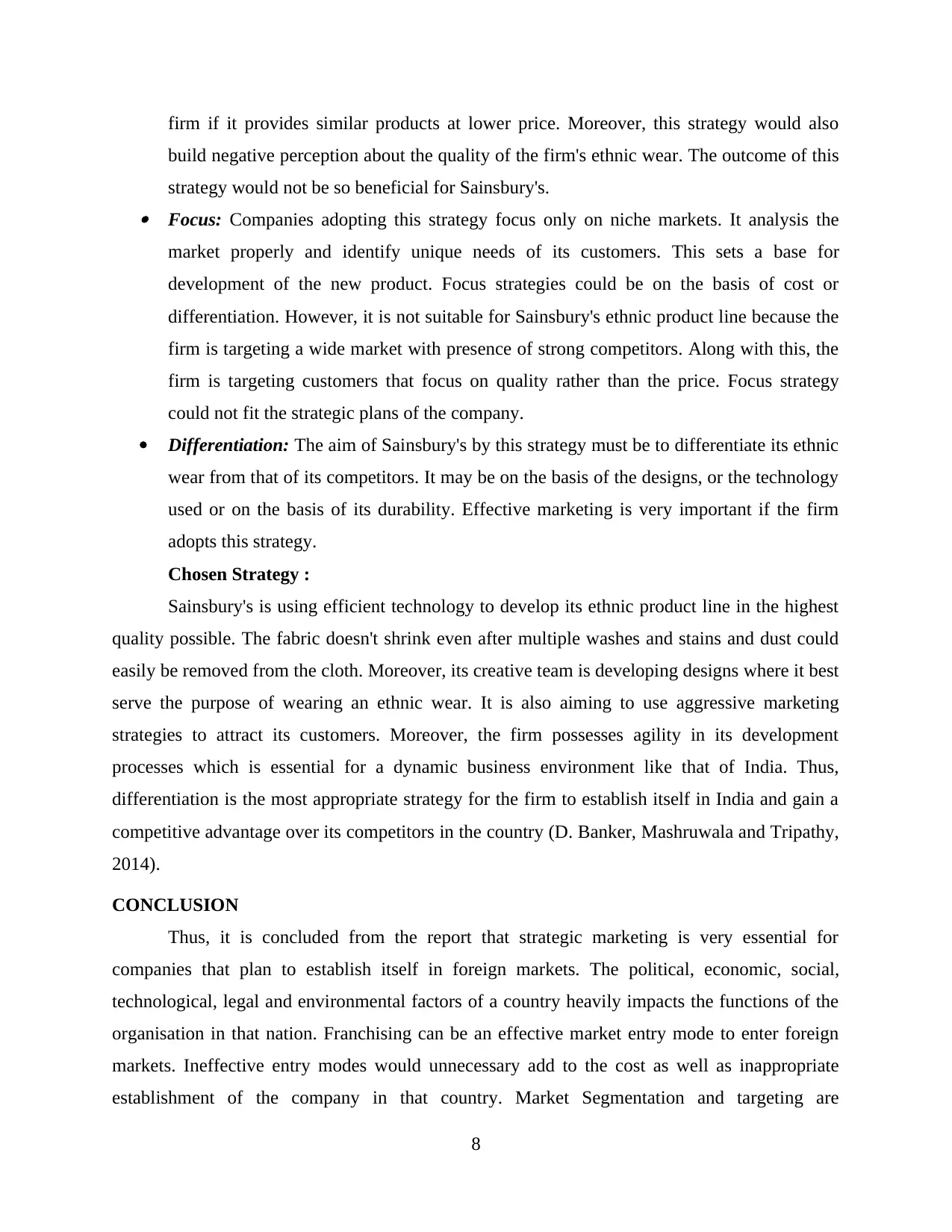
firm if it provides similar products at lower price. Moreover, this strategy would also
build negative perception about the quality of the firm's ethnic wear. The outcome of this
strategy would not be so beneficial for Sainsbury's. Focus: Companies adopting this strategy focus only on niche markets. It analysis the
market properly and identify unique needs of its customers. This sets a base for
development of the new product. Focus strategies could be on the basis of cost or
differentiation. However, it is not suitable for Sainsbury's ethnic product line because the
firm is targeting a wide market with presence of strong competitors. Along with this, the
firm is targeting customers that focus on quality rather than the price. Focus strategy
could not fit the strategic plans of the company.
Differentiation: The aim of Sainsbury's by this strategy must be to differentiate its ethnic
wear from that of its competitors. It may be on the basis of the designs, or the technology
used or on the basis of its durability. Effective marketing is very important if the firm
adopts this strategy.
Chosen Strategy :
Sainsbury's is using efficient technology to develop its ethnic product line in the highest
quality possible. The fabric doesn't shrink even after multiple washes and stains and dust could
easily be removed from the cloth. Moreover, its creative team is developing designs where it best
serve the purpose of wearing an ethnic wear. It is also aiming to use aggressive marketing
strategies to attract its customers. Moreover, the firm possesses agility in its development
processes which is essential for a dynamic business environment like that of India. Thus,
differentiation is the most appropriate strategy for the firm to establish itself in India and gain a
competitive advantage over its competitors in the country (D. Banker, Mashruwala and Tripathy,
2014).
CONCLUSION
Thus, it is concluded from the report that strategic marketing is very essential for
companies that plan to establish itself in foreign markets. The political, economic, social,
technological, legal and environmental factors of a country heavily impacts the functions of the
organisation in that nation. Franchising can be an effective market entry mode to enter foreign
markets. Ineffective entry modes would unnecessary add to the cost as well as inappropriate
establishment of the company in that country. Market Segmentation and targeting are
8
build negative perception about the quality of the firm's ethnic wear. The outcome of this
strategy would not be so beneficial for Sainsbury's. Focus: Companies adopting this strategy focus only on niche markets. It analysis the
market properly and identify unique needs of its customers. This sets a base for
development of the new product. Focus strategies could be on the basis of cost or
differentiation. However, it is not suitable for Sainsbury's ethnic product line because the
firm is targeting a wide market with presence of strong competitors. Along with this, the
firm is targeting customers that focus on quality rather than the price. Focus strategy
could not fit the strategic plans of the company.
Differentiation: The aim of Sainsbury's by this strategy must be to differentiate its ethnic
wear from that of its competitors. It may be on the basis of the designs, or the technology
used or on the basis of its durability. Effective marketing is very important if the firm
adopts this strategy.
Chosen Strategy :
Sainsbury's is using efficient technology to develop its ethnic product line in the highest
quality possible. The fabric doesn't shrink even after multiple washes and stains and dust could
easily be removed from the cloth. Moreover, its creative team is developing designs where it best
serve the purpose of wearing an ethnic wear. It is also aiming to use aggressive marketing
strategies to attract its customers. Moreover, the firm possesses agility in its development
processes which is essential for a dynamic business environment like that of India. Thus,
differentiation is the most appropriate strategy for the firm to establish itself in India and gain a
competitive advantage over its competitors in the country (D. Banker, Mashruwala and Tripathy,
2014).
CONCLUSION
Thus, it is concluded from the report that strategic marketing is very essential for
companies that plan to establish itself in foreign markets. The political, economic, social,
technological, legal and environmental factors of a country heavily impacts the functions of the
organisation in that nation. Franchising can be an effective market entry mode to enter foreign
markets. Ineffective entry modes would unnecessary add to the cost as well as inappropriate
establishment of the company in that country. Market Segmentation and targeting are
8
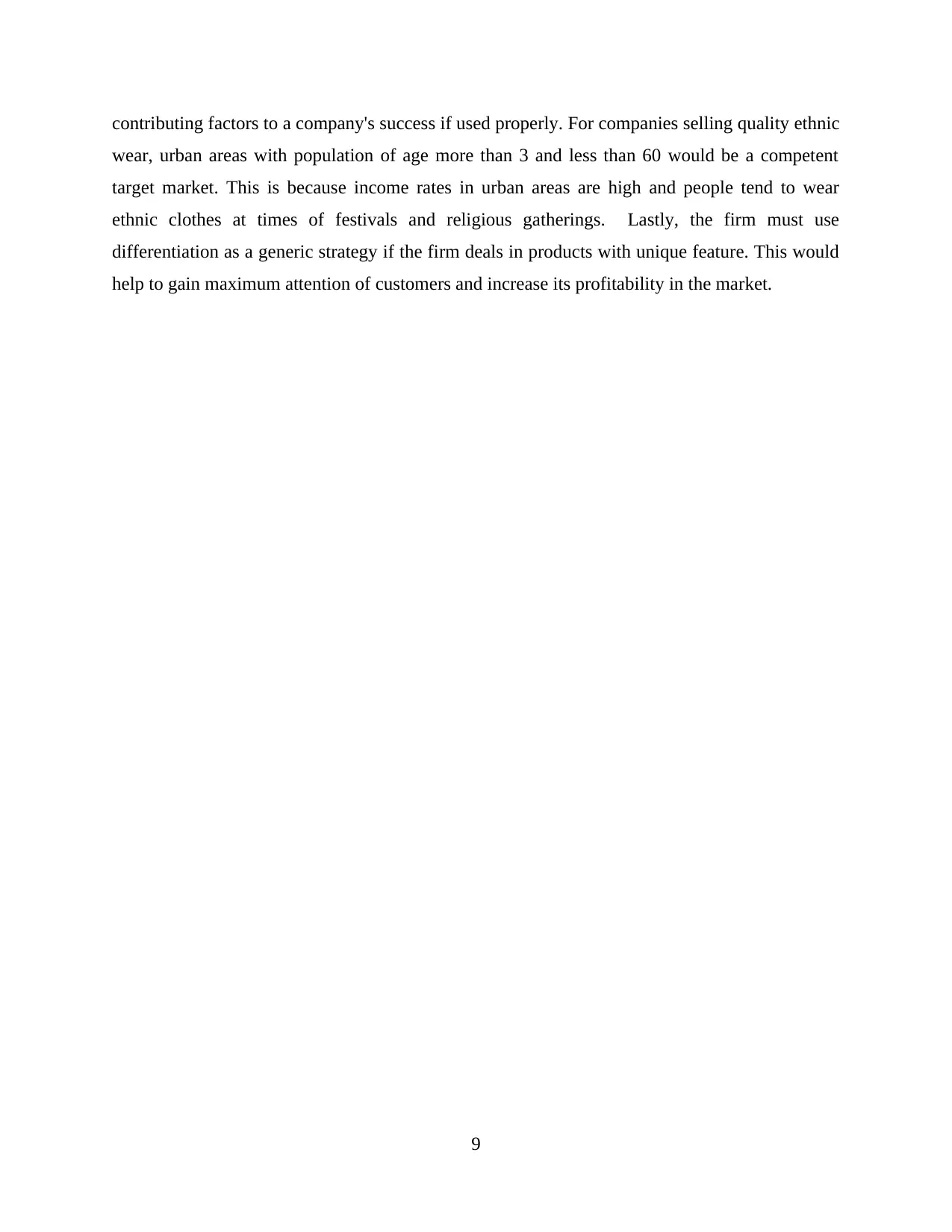
contributing factors to a company's success if used properly. For companies selling quality ethnic
wear, urban areas with population of age more than 3 and less than 60 would be a competent
target market. This is because income rates in urban areas are high and people tend to wear
ethnic clothes at times of festivals and religious gatherings. Lastly, the firm must use
differentiation as a generic strategy if the firm deals in products with unique feature. This would
help to gain maximum attention of customers and increase its profitability in the market.
9
wear, urban areas with population of age more than 3 and less than 60 would be a competent
target market. This is because income rates in urban areas are high and people tend to wear
ethnic clothes at times of festivals and religious gatherings. Lastly, the firm must use
differentiation as a generic strategy if the firm deals in products with unique feature. This would
help to gain maximum attention of customers and increase its profitability in the market.
9
⊘ This is a preview!⊘
Do you want full access?
Subscribe today to unlock all pages.

Trusted by 1+ million students worldwide
1 out of 14
Related Documents
Your All-in-One AI-Powered Toolkit for Academic Success.
+13062052269
info@desklib.com
Available 24*7 on WhatsApp / Email
![[object Object]](/_next/static/media/star-bottom.7253800d.svg)
Unlock your academic potential
Copyright © 2020–2025 A2Z Services. All Rights Reserved. Developed and managed by ZUCOL.





